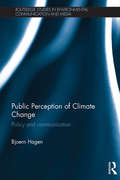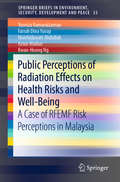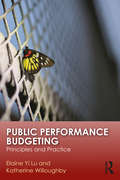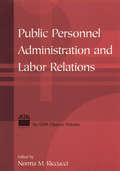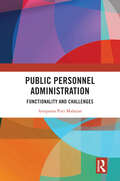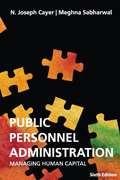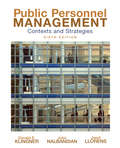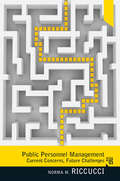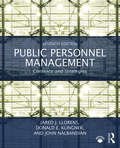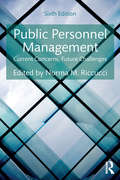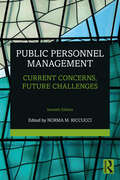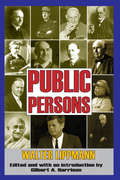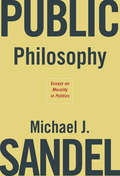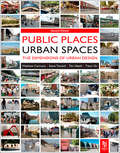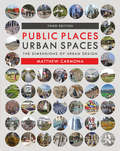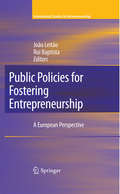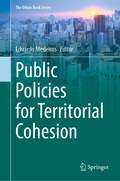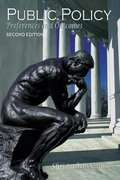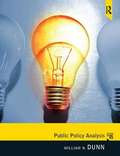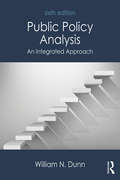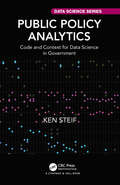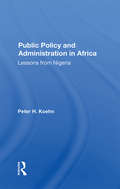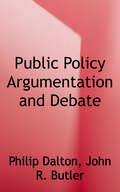- Table View
- List View
Public Perception of Climate Change: Policy and Communication (Routledge Studies in Environmental Communication and Media)
by Bjoern HagenDespite the findings on global climate change presented by the scientific community, there remains a significant gap between its recommendations and the actions of the public and policy makers. So far scientists and the media have failed to successfully communicate the urgency of the climate change situation in such a way that long-term, comprehensive, and legally binding policy commitments are being made on the national and international level. This book examines the way the public processes information, how they perceive threats and other perceptual factors that have a significant effect on how and to what degree climate change mitigation and adaptation strategies are supported. Understanding public risk perception plays a vital role in communicating the challenges of global climate change. Using a diverse range of international case studies, this book explores the nature of public perceptions of climate change and identifies the perception factors which have a significant impact on the public’s willingness to support global climate change policies or commit to behavioral changes to reduce greenhouse gas emissions and improve urban resiliency. The comparative study of social and cultural factors, beliefs, attitudes and trust provides an international overview of best practices regarding the design, implementation and generation of public support for climate change policies at a global level. Offering valuable insight into climate change and risk communication, the book should be of interest to students and scholars of environment studies, politics, urban planning, and media and cultural studies.
Public Perceptions of Radiation Effects on Health Risks and Well-Being: A Case of RFEMF Risk Perceptions in Malaysia (SpringerBriefs in Environment, Security, Development and Peace #33)
by Kwan-Hoong Ng Yusniza Kamarulzaman Farrah Dina Yusop Noorhidawati Abdullah Azian MadunThis book reports on the investigation of the public’s perception of Radio Frequency Electromagnetic Field (RF-EMF) radiation effects on health and well-being, in Malaysia. It elaborates on how understanding the impact of perceived risk is essential in order to investigate the explanatory value and effectiveness of interventions influencing these beliefs. The book expands on the knowledge and understanding of different risk perception related to radiation in order to explain the gap in literature regarding the relationship between risk perceptions that lead to public behaviors. In doing so, the book presents empirical findings of a national study that unveils two key factors affecting public risk perceptions: psycho-graphic and personal factors. It offers a more collective and cultural understanding of public perceptions on radiation risks via a systematic mixed-method research approach. Research in the book also show that while the radiation risk is recognizable and unavoidable, the relevant stakeholders should be more proactive and committed to communicate and rectify the perception of radiation. The book thus serves as a valuable source of reference to understand the debate and to invite more participatory dialogues on radiation risk perceptions among public.
Public Performance Budgeting: Principles and Practice
by Elaine Yi Lu Katherine WilloughbyPerformance budgeting involves costs, from the drafting and passage of legal foundations, and the political capital and will to implement it, to training personnel to create a performance-oriented culture, and information technology requirements to track performance. Through comprehensive examination of performance budgeting laws, in-depth interviews of those practicing in government agencies, and quantitative survey analysis, Public Performance Budgeting examines the influence of performance measurement and evaluation on all phases of the budgeting process. Lu and Willoughby present original research and case studies to explore how performance is linked to public budgets and government results, its impacts on budgeting systems, and possible unintended consequences. A summary assessment of how performance measurement could and should play a role in furthering performance budgeting is explored in a concluding chapter. The first of its kind to spotlight budget practice through the lens of juvenile justice, this book is required reading for all those studying public budgeting, management, and policy.
Public Personnel Administration and Labor Relations
by Norma M RiccucciThe readings in this volume will enlighten and enliven the contents of any standard public administration text covering human resource management. Selected mainly from the pages of Public Administration Review and Review of Public Personnel Administration, these classic articles trace the historical and evolutionary development of the fields of public personnel administration and labor relations from the point at which the first civil service law was passed - the Pendelton Act in 1883 - through the 21st century. The collection covers everything from the seminal concerns of civil service (e.g., keeping spoils out) to topics that early reformers would never have envisioned (e.g., affirmative action and drug testing). These works continue to inform the theory and practice of public personnel and labor relations. To facilitate an instructor's ability to assign readings that illuminate lectures and course material, a correlation matrix on the M.E. Sharpe website shows how this book can be used easily alongside eight leading textbooks.
Public Personnel Administration: Functionality and Challenges
by Anupama Puri MahajanThis book addresses the processes and concerns within the purview of public personnel administration which is the key to success in carrying out governmental responsibilities and duties. With special focus on Indian administrative system, this volume probes into how public personnel administration is a critical aspect of the public sector that involves enhanced management of human resources. It also studies the evolution of public personnel administration in countries like the USA, UK, France, and Germany. Besides discussing the personnel processes in the post pandemic age, the book also examines the challenges that governments face on a global level. This title will be useful to students, researchers and teachers of Public Administration, Public Policy, Political Science, and General Management. The book will also be an invaluable companion to the policymakers in the government sector as it will strengthen their conceptual understanding of the subject.
Public Personnel Administration: Managing Human Capital
by N. Joseph Cayer Meghna SabharwalIn an era of "doing more with less," public personnel managers and administrators face constantly changing pressures and concerns. <P><P>The 6th edition includes new discussion on the impact of social media on personnel management and updated research on sexual orientation, diversity, generational differences and inclusion in the workplace
Public Personnel Management
by Jared J Llorens Donald Klingner John NalbandianDistinguished by its coherent values perspective, Public Personnel Management focuses on the conflicts, political processes, and management techniques that provide the context for personnel administration in the public sector. Organized around the four principal personnel functions that must be fulfilled in any complex organization, this book provides a comprehensive exploration of the planning, acquisition, development, and sanctions within public personnel management.
Public Personnel Management
by Norma M. RiccucciUpdated in a new 5th edition, Public Personnel Management, by Norma M. Riccucci, is a concise and accessible reader containing all original articles addressing the most current issues in public personnel management. Written expressly for the text by leading scholars, all of the articles are either new to this edition or substantially revised. Each article focuses on specific-often controversial-issues in public personal management, such as comparative personnel management, pensions, sexuality, health, succession planning, unions, and the multi-generational workforce.
Public Personnel Management: Contexts and Strategies
by John Nalbandian Jared J. Llorens Donald E. KlingnerNow in a thoroughly revised 7th edition, Public Personnel Management focuses on the critical issues and common processes in the management of public sector personnel. In keeping with prior editions, the text centers on the core processes within public human resource management: strategic workforce planning, effective recruitment and retention, workforce development, and employee relations. Designed to further address the ways in which expectations for human resource managers have changed and developed in recent years, the 7th edition includes several new features and improvements: Substantially restructured, updated, and additional case studies and student exercises. Coverage of how the field of Public HRM has been influenced by the two most recent national recessions, economic downturns at the state and local level, privatization and contracting trends at all levels of government, the growing presence of millennial employees in the workplace, issues surrounding social media use within the workplace, the evolving goals of social equity and diversity, and the shifting role and influence of labor unions. Discussions of how the growth in information technology capabilities has influenced the major processes within HRM, from workforce analysis through big data analytics to the explosion in automated recruitment, assessment, and instructional technologies. For the first time, the text includes an online Instructor's Manual, PowerPoint slides, discussion questions, and suggestions for further reading to make it even easier to assign and use this classic text in the classroom. Providing the most up-to-date and thorough overview of the history and practice of public human resource management for both undergraduate and graduate students, Public Personnel Management, 7e remains the beloved text it ever was, ideal for introductory courses in Public Personnel Management, Public Human Resource Management, and Nonprofit Personnel Management.
Public Personnel Management: Current Concerns, Future Challenges
by Norma M. RiccucciPublic Personnel Management has served as an essential, concise reader for public personnel and human resource management courses in the fields of public administration, political science, and public policy over the last 25 years. Since the first edition published in 1991, the book has offered professors and students alike an in-depth look at cutting-edge developments beyond standard textbook coverage, to provide a broad understanding of the key management and policy issues facing public and nonprofit HRM today. Original chapters are written expressly for the text by leading public administration scholars, each focusing on specific and often controversial concerns for public personnel management, such as pensions, gender and sexuality, healthcare, unions, and a multi-generational workforce. Now in an extensively revised sixth edition, Public Personnel Management presents new, original chapters to examine developments of interest to researchers and practitioners alike, including: remote working, cybersecurity, public service motivation, the abandonment of traditional civil service at the state and local levels, the Affordable Care Act and its implications for practice, pension systems and labor relations, affirmative action, social equity, legislation surrounding LGBT rights, and – as the field of public personnel management becomes more internationalized – a chapter addressing public personnel management across Europe. This careful and thoughtful overhaul will ensure that Public Personnel Management remains a field-defining book for the next 25 years.
Public Personnel Management: Current Concerns, Future Challenges
by Norma M. RiccucciPublic Personnel Management has served as an essential, concise reader for public personnel and human resource management courses in the fields of public administration, political science, and public policy for more than 30 years. Since the first edition published in 1991, the book has provided professors and students alike with an in-depth look at cutting-edge developments beyond standard textbook coverage, to cultivate a broad understanding of the key management and policy issues facing public and nonprofit HRM today. Original chapters are written expressly for the text by leading public administration scholars, each focusing on specific and sometimes controversial concerns for public personnel management, such as social equity, labor relations, public employee rights, and the operation of nonprofits. Now in an extensively revised seventh edition, Public Personnel Management presents new, original chapters to examine developments of interest to researchers and practitioners alike, including: new ways of working (NWW), remote work, the effects of the COVID-19 pandemic on public service workforces, work-life balance, patterns of discrimination and employees’ perceptions of fairness, affirmative action, generational differences in the workforce, and – as the field of public personnel management becomes more internationalized – chapters addressing human resource management across Europe and a chapter NWW practices in Switzerland. These, together with other chapters, ensure that Public Personnel Management will remain a field-defining book for the next 30 years.
Public Persons
by Walter LippmannThis set of brief pieces examines the relation of power to knowledge. Lippmann paid little homage to the innate wisdom of the people. While he had no wish to disenfranchise citizens, he believed elites drove the engines of power. His point was that liberty and democracy require government that will, when necessary, "swim against the tides of private feelings." Because the public is too divided, poorly informed, and too self-regarding, authority has to be delegated, perhaps to "intelligence bureaus," or at least to those who are wiser than the many that have the power to decide vexing questions on their own merits.Lippmann knew that in the real world we cannot expect to be ruled by philosopher-kings. While ready to settle for less, he was not ready to settle for politicians who get ahead "only as they placate, appease, bribe, seduce, bamboozle and otherwise manage to manipulate demanding and threatening elements in their constituencies." The seducers and bamboozlers were generally in charge, and because they were in an age "rich with varied and generous passions" they had become disorderly and deranged.Public Persons is the informal side of The Public Philosophy. Lippmann tries to account for the decline of Western democracies and prescribe for their revival. He concludes that it is not possible to discover by rational inquiry the conditions that must be met if there is to be a good society. Lippmann saw tension between private impulses and transcendent truth as the "inexhaustible theme of human discourse." The occasional harmonies in the lives of saints and the deeds of heroes and the excellence of genius are glorious. But glory was the exception, wretchedness the rule. In this casual volume both are given a human face.
Public Philosophy: Essays on Morality in Politics
by Michael J. SandelIn this book, Michael Sandel takes up some of the hotly contested moral and political issues of our time, including affirmative action, assisted suicide, abortion, gay rights, stem cell research, the meaning of toleration and civility, the gap between rich and poor, the role of markets, and the place of religion in public life. He argues that the most prominent ideals in our political life--individual rights and freedom of choice--do not by themselves provide an adequate ethic for a democratic society. Sandel calls for a politics that gives greater emphasis to citizenship, community, and civic virtue, and that grapples more directly with questions of the good life. Liberals often worry that inviting moral and religious argument into the public sphere runs the risk of intolerance and coercion. These essays respond to that concern by showing that substantive moral discourse is not at odds with progressive public purposes, and that a pluralist society need not shrink from engaging the moral and religious convictions that its citizens bring to public life.
Public Places - Urban Spaces
by Steve Tiesdell Tim Heath Taner OcPublic Places Urban Spaces, 2e, is a thorough introduction to the principles of urban design theory and practice. Authored by experts in the fields of urban design and planning, it is designed specifically for the 2,500 postgraduate students on Urban Design courses in the UK, and 1,500 students on undergraduate courses in the same subject.The 2e of this tried and trusted textbook has been updated with relevant case studies to show students how principles have been put into practice. The book is now in full color and in a larger format, so students and lecturers get a much stronger visual package and easy-to-use layout, enabling them to more easily practically apply principles of urban design to their projects.Sustainability is the driving factor in urban regeneration and new urban development, and the new edition is focused on best sustainable design and practice. Public Places Urban Spaces is a must-have purchase for those on urban design courses and for professionals who want to update and refresh their knowledge.
Public Places Urban Spaces: The Dimensions of Urban Design
by Matthew CarmonaPublic Places Urban Spaces provides a comprehensive overview of the principles, theory and practices of urban design for those new to the subject and for those requiring a clear and systematic guide. In this new edition the book has been extensively revised and restructured. Carmona advances the idea of urban design as a continuous process of shaping places, fashioned in turn by shifting global, local and power contexts. At the heart of the book are eight key dimensions of urban design theory and practice—temporal, perceptual, morphological, visual, social, functional—and two new process dimensions—design governance and place production. This extensively updated and revised third edition is more international in its scope and coverage, incorporating new thinking on technological impact, climate change adaptation, strategies for urban decline, cultural and social diversity, place value, healthy cities and more, all illustrated with nearly 1,000 carefully chosen images. Public Places Urban Spaces is a classic urban design text, and everyone in the field should own a copy.
Public Policies for Fostering Entrepreneurship
by Rui Baptista João LeitãoThe contribution of this book is to join in the same volume a set of theoretical visions and empirical assessments by leading scholars about public policies towards entrepreneurship in Europe and how to rethink them. The book is divided in two parts: Part I - Entrepreneurship Policies - A European Framework; and Part II - Entrepreneurship Policy in Countries and Regions. In Part I various theoretical approaches are presented by prominent scholars from around the world. They point to the need for the European economy to be the subject of regional reorganization, based on concentrations of production activities with a strong component of knowledge and technology. This book appears at a particularly challenging time, in economic and social terms, when entrepreneurship and innovation assume particular strategic importance, inasmuch as endogenous growth should be considered by policy-makers and also by business-people and citizens as one of the driving forces that can catalyze regional economies. The Entrepreneurship Policy examples contained in Part II from European countries in Scandinavia, Iberia, Germany, Turkey and the UK explore the implications for research, practice and policy-making in those regions.
Public Policies for Territorial Cohesion (The Urban Book Series)
by Eduardo MedeirosThis book introduces a comprehensive and updated analysis of the role of public policies to promote territorial cohesion processes and trends in a given territory. By being the first book taking a reflective and holistic approach on how public policies can lead to more cohesive and balanced territories, it advances theoretical avenues for academics and showcases current academic research to policymakers and practitioners by focusing on how public policies, being implemented in different territorial scales (urban, local, regional, national, and European), can actively contribute to foster territorial cohesion trends in a given territory. This reflective approach provides an opportunity for thinking about what lessons can be learned from past and ongoing experiences and how they can improve future implementation of public policies more effectively and efficiently toward territorial cohesion, since all existing analyses show that at the national level, no European country has achieved territorial cohesion trends over the past decades. As such, this book acts as a valid and useful policy manual that effectively contributes to inverting current territorial exclusion trends at the national level, by highlighting best policy practices and a comprehensive introduction to contemporary thinking about how public policies can play a decisive role in boosting territorial cohesion processes in a given territory.
Public Policies in Shared Societies
by Mari FitzduffCommunities throughout the world are increasingly diverse in their racial, ethnic and religious make up. Using examples drawn from over 50 countries in a variety of fields from economics to education, this book explores how governmental, economic and social institutions are adapting their policies to create more cohesive and peaceful societies.
Public Policy
by Christopher SimonBuilt on the premise that all public policy is ultimately grounded in the philosophy of governance, Christopher A. Simon's second edition continues to approach policy by combining normative and empirical perspectives. This deeply revised second edition continues to expose students to the basis of preferences, policy-making processes, policy history, and current policy decisions and outcomes. Chapters conclude with a case studies engaging students in the application of their theoretical knowledge to the real world, and encouraging them to be informed and active citizens. Key Features: Alternate tables of content are included to provide professors and students with flexible, easy-to-implement options for approaching and assigning public policy. Case studies provide real-world examples that concretely illustrate theoretical concepts. End-of-Chapter questions reinforce key concepts and encourage students to think critically about the chapter topics. Each chapter ends with a two-part summary that offers a review of the major chapter concepts ("Lessons Learned") and puts them in context ("The Big Picture").
Public Policy Analysis
by William N DunnPublic Policy Analysis, the most widely cited book on the subject, provides readers with a comprehensive methodology of public policy analysis. Starting from the premise that policy analysis is an applied social science discipline designed for solving practical problems facing public and nonprofit organizations, the book bridges the gap between theory and practice. It provides practical skills for conducting policy analysis and communicating findings through memos, position papers, and other forms of structured analytical writing. The book asks readers to critically anazlye the arguments of policy practitioners as well as political scientists, economists, and political philosophers.
Public Policy Analysis (Fifth Edition)
by William N. DunnPublic Policy Analysis, the most widely cited book on the subject, provides readers with a comprehensive methodology of public policy analysis. Starting from the premise that policy analysis is an applied social science discipline designed for solving practical problems facing public and nonprofit organizations, the book bridges the gap between theory and practice. It provides practical skills for conducting policy analysis and communicating findings through memos, position papers, and other forms of structured analytical writing. The book asks readers to critically anazlye the arguments of policy practitioners as well as political scientists, economists, and political philosophers.
Public Policy Analysis: An Integrated Approach
by William N. DunnPublic Policy Analysis, the most widely cited book on the subject, provides students with a comprehensive methodology of policy analysis. It starts from the premise that policy analysis is an applied social science discipline designed for solving practical problems facing public and nonprofit organizations. This thoroughly revised sixth edition contains a number of important updates: Each chapter includes an all-new "big ideas" case study in policy analysis to stimulate student interest in timely and important problems. The dedicated chapter on evidence-based policy and the role of field experiments has been thoroughly rewritten and expanded. New sections on important developments in the field have been added, including using scientific evidence in public policymaking, systematic reviews, meta-analyses, and "big data." Data sets to apply analytical techniques are included online as IBM SPSS 23.0 files and are convertible to Excel, Stata, and R statistical software programs to suit a variety of course needs and teaching styles. All-new PowerPoint slides are included to make instructor preparation easier than ever before. Designed to prepare students from a variety of academic backgrounds to conduct policy analysis on their own, without requiring a background in microeconomics, Public Policy Analysis, Sixth Edition helps students develop the practical skills needed to communicate findings through memos, position papers, and other forms of structured analytical writing. The text engages students by challenging them to critically analyze the arguments of policy practitioners as well as political scientists, economists, and political philosophers.
Public Policy Analytics: Code and Context for Data Science in Government (Chapman & Hall/CRC Data Science Series)
by Ken SteifPublic Policy Analytics: Code & Context for Data Science in Government teaches readers how to address complex public policy problems with data and analytics using reproducible methods in R. Each of the eight chapters provides a detailed case study, showing readers: how to develop exploratory indicators; understand ‘spatial process’ and develop spatial analytics; how to develop ‘useful’ predictive analytics; how to convey these outputs to non-technical decision-makers through the medium of data visualization; and why, ultimately, data science and ‘Planning’ are one and the same. A graduate-level introduction to data science, this book will appeal to researchers and data scientists at the intersection of data analytics and public policy, as well as readers who wish to understand how algorithms will affect the future of government.
Public Policy And Administration In Africa: Lessons From Nigeria
by Peter KoehnOriginally published in 1990. A look at the vast, historically and socially complex nature of the Nigeria This book is intended to share what he has learned about public policy and administration in Africa over the past ten years. This book is based upon a decade of research, reflection, and writing. The field research period corresponds with the
Public Policy Argumentation and Debate: A Practical Guide for Advocacy
by Philip Dalton John R. ButlerThrough an exclusive focus on public policy advocacy as a practical endeavor, the authors Philip Dalton and John R. Butler depart from approaches to debate education that focus on the rules of simulated, academic debate formats. Beginning with the assumption that readers have already developed a basic capacity to argue, they offer practical guidance for determining the fundamental issues that make up a controversy and what expectations public audiences will have for advocacy based on the issues and the burdens of advocates challenging or defending the status quo. Through examples that span a wide range of advocacy situations and subjects of contemporary importance, the authors build a framework for public policy advocacy that is organic to the communication discipline, recover and refresh foundational lessons about the uses of evidence, and provide critical questions that can be used to develop and communicate policy proposals that are sensible and appealing. Written in an accessible, respectful, and motivational style, the book is suitable for students of debate, professionals who function as advocates, and people who find themselves wishing to voice their opinion on an issue of concern.
